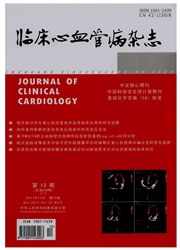

 中文摘要:
中文摘要:
目的:探讨1型多聚二磷酸腺苷核糖合成酶[poly(ADP-ribose)polymerase-1,PARP-1]对去甲肾上腺素(norepinephrine,NE)诱导培养的大鼠心肌细胞重构过程中的调节作用及其机制。方法:①培养乳鼠心肌细胞,10μmol/LNE刺激心肌细胞24h后,使用实时定量PCR法检测c-fos、ANP、β-MHC、α-MHC基因表达水平;观察抗氧化剂维生素C(VitC)和PARP-1抑制剂3-氨基苯甲酰胺(3-aminobenzamide,3-AB)对上述基因表达的影响。②检测心肌细胞内活性氧(ROS)水平,及PARP活性和PARP-1表达水平的变化。结果:NE诱导心肌细胞内c-fos、ANP、β-MHC基因表达水平明显增加。心肌细胞内ROS产生增加,PARP激活,PARP-1蛋白表达亦显著增加。使用VitC减少ROS产生,抑制了NE诱导的PARP-1活性及表达的增加,NE诱导的c-fos、ANP基因表达也显著降低。3AB可明显减少NE诱导的c-fos、ANP、β-MHC基因的表达及βMHC/α-MHC的比值。结论:NE刺激心肌细胞增加了细胞内ROS的产生,大量的ROS激活了PARP并使PARP-1的表达水平显著增加,PARP-1参与调节了心肌重构过程胚胎基因c-fos、ANP、β-MHC、α-MHC的异常表达。PARP-1可能是心肌重构过程中的重要调节机制之一。
 英文摘要:
英文摘要:
Objective:To investigate the role of poly (ADP-ribose) polymerase-1 (PARP-1) in NE induced cardiomyocyte remodeling in primary cultured neonatal cardiomyocytes. Method:Primary cultured neonatal cardiomyocytes were divided into 4 groups. Group 1 (control group) received no treatment. Group 2 (NE group) received treatment with NE (10 μmol/L) alone for 24 hours. Group 3 (3AB group) were pretreated with 15 mmol/L PARP inhibitor 3-aminobenzamide (3AB) for 1 hour, followed by additional incubation with NE (10 μmol/L) for 24 hours. Group 4 (VitC group) were pretreated with Vitamin C (1.4mmol/L) followed by NE treatment for 24 hours. Intraeellular ROS level was measured with ROS-sensitive fluorophore DCF-DA by Fluoromax-3 speetrofluorimeter. PARP activity of cultured cells was measured with TCA precipitation method. Expression of PARP-1 in cardiomyocytes was measured with Western blot. mRNA levels of c-fos, atrial natriuretic peptide (ANP), α-myosin heavy chain (MHC) and β-MHC gene were measured with real-time RT-PCR. Result: PARP inhibitor 3AB significantly prevented NE induced 1) increase in PARP activity and PARP-1 expression; 2) increases in β-MHC, c- fos and ANP mRNA levels and ratio of β-MHC/α-MHC in cardiomyocyte; 3) increase in ROS generation. Antioxidant vitamin C significantly prevented NE induced increases in PARP activity and PARP-1 expression in cardiomyocytes; thereby significantly decreased mRNA level of c-fos and ANP. Conclusion:Activation of PARP/PARP- 1 contributes importantly to the abnormal gene expression in NE treated cultured neonatal cardiomyocytes.
 同期刊论文项目
同期刊论文项目
 同项目期刊论文
同项目期刊论文
 期刊信息
期刊信息
